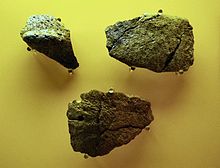Tennessee
![]()
This article is about the US state; for other meanings of terms with the same name, see Tennessee (disambiguation).
Tennessee (English pronunciation [![]()
![]() ˌtɛnəˈsiː]; Cherokee: ᏔᎾᏏ Ta-Na-Si) is a state of the United States of America and is one of the southern states. The name Tennessee comes from Tanasi, the name of an Indian settlement on the Little Tennessee River. One of Tennessee's epithets is Volunteer State - "state of volunteers". It comes from the time of the British-AmericanWar, in which many Tennessee citizens fought as volunteers for their country.
ˌtɛnəˈsiː]; Cherokee: ᏔᎾᏏ Ta-Na-Si) is a state of the United States of America and is one of the southern states. The name Tennessee comes from Tanasi, the name of an Indian settlement on the Little Tennessee River. One of Tennessee's epithets is Volunteer State - "state of volunteers". It comes from the time of the British-AmericanWar, in which many Tennessee citizens fought as volunteers for their country.
Tennessee is famous for the blues, the birth of rock 'n' roll (Memphis) and country music (Nashville), as well as its whiskey (Jack Daniel's and George Dickel).
History
Paleo-Indians inhabited what is now Tennessee 12,000 years ago. In addition to projectile points, the skeleton of a mastodon was found in Williamson County with cut marks typical of this earliest period.
Dating to the Archaic Period (ca. 8000-1000 BC), the Icehouse Bottom archaeological site south of Fort Loudoun in Monroe County has been dated to ca. 7500 BC. Other sites of this period, but much younger are Rose Island, just a few miles downstream from Icehouse Bottom, and the Eva site in Benton County. It is attributed to the Big Sandy culture and was inhabited between 2000 and 1000, possibly 500 BC.
Dating to the Woodland period (1000 BCE-1000 CE), the Pinson Mounds in Madison County and Old Stone Fort in Coffee County have been excavated, both dating to the first half of the 1st millennium CE. In the process, the Pinson Mounds are among the largest mounds of the Middle Woodland Period in the southeastern United States. At least 12 mounds belong to this structure. The Old Stone Fort site is an extensive ceremonial site with a complicated access route. It was located on a barely accessible peninsula at the time.
Dating to the Mississippi Culture era (c. 1000-1600) are villages along most of the state's riverways, including Chucalissa near Memphis, Mound Bottom in Cheatham County, the Shiloh Mounds in Hardin County, and the Toqua site in Monroe County. Excavations at the McMahan Mound site in Sevier County-where a mound 73 m wide was found dating from around 1200 to 1500-and at Townsend in Blount County-where archaeologists unearthed a village palisade dating from around 1200-further clarified the picture of these mound builders in Tennessee.
From 1539 to 1543, the Spanish explorer Hernando de Soto passed through the area east of the Mississippi River. To which tribes the archaeological remains of the 16th and 17th centuries are to be assigned is disputed. In the 18th century, only the Cherokee lived permanently in Tennessee. The Chickasaw controlled the western part of what is now the state, but there is no evidence that they did anything more than hunt there. The Shawnee and Creek briefly occupied some territory, but there is virtually no archaeological evidence.
At the beginning of settlement by European colonists, most of the Native Americans were pushed south and west, especially the Muskogee and Yuchi tribes. Until the founding of the state, the area was under the administration of North Carolina and was known as the Southwest Territory. The Southwest Territory was considered a lawless area for a very long time because the North Carolina government failed to establish sufficient administration.
From 1785 to 1788, the first attempt was made to form a state of the United States. The state of Franklin was founded in the east of what is now Tennessee. After five years of quarreling with the North Carolina government and frequent Indian raids, the government in Greeneville collapsed and the territory came back under the control of North Carolina. On June 1, 1796, Tennessee joined the United States as the 16th state by incorporation approved by the Senate. From 1838 to 1839, the remaining approximately 17,000 Cherokee were deported to western Arkansas. This forced march, which resulted in the deaths of about 4,000 Indians, is known as the Trail of Tears.
On June 8, 1861, Tennessee became the last of the Southern states to secede from the Union after a referendum that was successful on the second attempt, and it joined the Confederate States of America on July 2. There was a clear majority of opponents of secession in certain areas, and after the referendum they voted at a convention in Greeneville to keep East Tennessee in the United States, without being able to prevail against Nashville. During the war, several battles took place on Tennessee soil, such as the Battle of Chattanooga, the Battle of Nashville, and the Battle of Franklin. After the AmericanCivil War, the state gave itself a new constitution on February 22, 1865, abolishing slavery, and ratified the 14th Amendment to the U.S. Constitution on July 18, 1866, making Tennessee the first of the seceding states to rejoin the United States (on July 24 of the same year).
In the 20th century, Tennessee experienced an enormous economic boom. In particular, the Oak Ridge National Laboratory made Tennessee a major industrial location in the USA. In the 1960s and 1970s, the state was the focus of the civil rights movement, which fought against the then prevailing racial segregation. From the point of view of the fighters for equal rights, Tennessee was one of the most backward states. It wasn't until 1967 that Tennessee was forced by the Supreme Court to become one of the last states in the U.S. to lift its ban on interracial marriages. In 1975, the U.S. Supreme Court declared illegal a Tennessee law that mandated that the pseudoscience of intelligent design and the theory of evolution be given equal time in biology classes in Tennessee's public schools.

One of the Pinson Mounds

Soapstone artifacts from the Archaic Period (c. 8000-2000 B.C.), Great Smoky Mountains Heritage Center, Townsend.
Geography
Neighbouring countries
Tennessee is bordered by the states of Kentucky and Virginia to the north, North Carolina to the east, Georgia, Alabama and Mississippi to the south, and Arkansas and Missouri to the west. This makes Tennessee (along with Missouri, which also borders eight states) the US state with the largest number of neighboring states. The Tennessee River flows through the state.
Structure
Tennessee consists scenically as well as in cultural and economic terms of three different major regions, which also play a role in the administrative structure of the state in different places, the so-called "Grand Divisions" of East Tennessee (East Tennessee), Middle Tennessee (Middle Tennessee) and West Tennessee (West Tennessee). While East Tennessee is dominated by the Appalachian Mountains, Middle Tennessee has rolling hills and fertile river valleys, also the capital Nashville is located in Middle Tennessee. West Tennessee, located between the Tennessee River and the Mississippi River, is already geographically part of the Gulf Coastal Plain. Each of the three "divisions" covers about one third of the state territory.
The major regions are defined by state law; the Tennessee Code designates the individual counties of each "division". The regions have legal significance, for example, insofar as a certain proportional representation between them must be observed when filling judgeships (for example, at the Tennessee Supreme Court) or on boards of directors. Symbolically, the three "divisions" (also called the "three Tennesseans") are represented in the three stars of the state flag.
- List of counties in Tennessee

Border sign at Interstate 65
Search within the encyclopedia